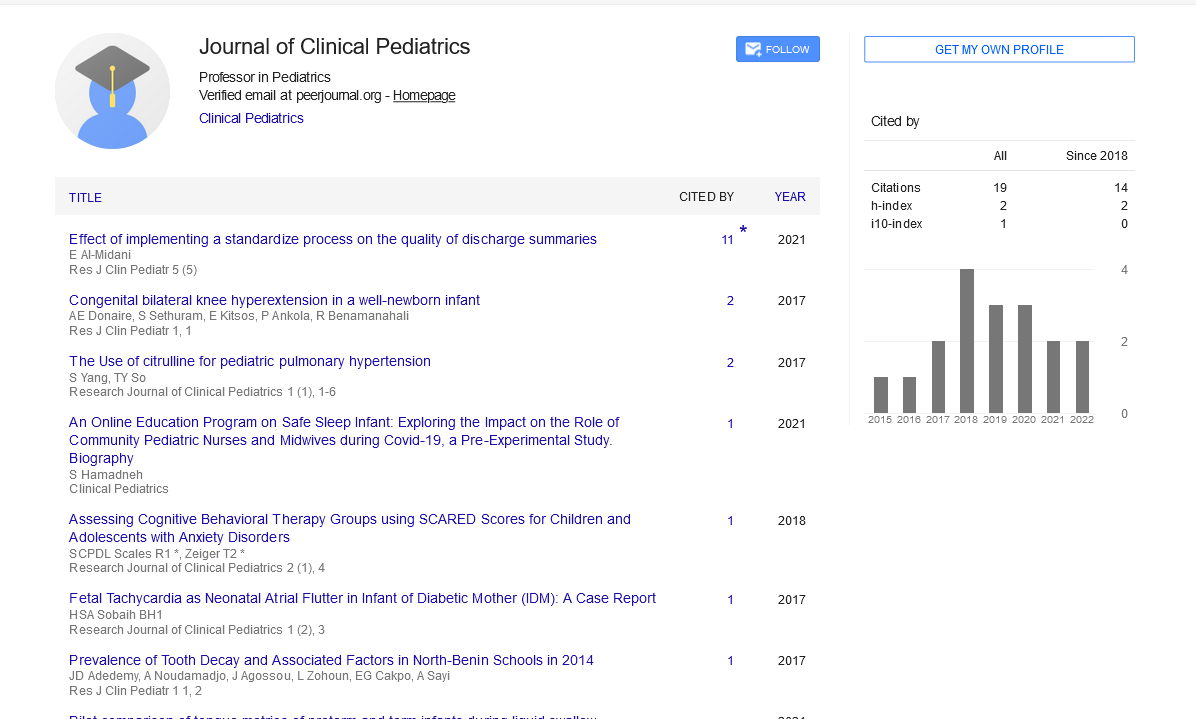Perspective, Res J Clin Pediatr Vol: 7 Issue: 4
Pediatric Dermatology: Its Diagnosis and Treatment Methods
Zohn Kelley*
1Department of Pediatrics, Charles R. Drew University of Medicine & Science, Los Angeles, United States of America
*Corresponding Author: Zohn Kelley,
Department of Pediatrics, Charles R. Drew
University of Medicine & Science, Los Angeles, United States of America
E-mail: zohnkelley@cdrewu.edu
Received date: 27 November, 2023, Manuscript No. RJCP-24-128400;
Editor assigned date: 30 November, 2023, PreQC No. RJCP-24-128400 (PQ);
Reviewed date: 07 December, 2023, QC No. RJCP-24-128400;
Revised date: 21 December, 2023, Manuscript No. RJCP-24-128400 (R);
Published date: 28 December, 2023 DOI: 10.4172/rjcp.1000163
Citation: Kelley Z (2023) Pediatric Dermatology: Its Diagnosis and Treatment Methods. Res J Clin Pediatr 7:4.
Description
Pediatric dermatology is a specialized branch of medicine that focuses on diagnosing and treating skin conditions in infants, children, and adolescents. The skin is the body's largest organ and plays an important role in protecting against infections, regulating temperature, and providing sensory input. Children's skin is unique, and their dermatological needs differ significantly from those of adults due to their rapid growth and developmental changes.
Children's skin is inherently different from adult skin. It is thinner, more delicate, and has a higher surface area-to-body weight ratio. As a result, children are more susceptible to certain skin conditions, including diaper rash, eczema, and infections like impetigo. Additionally, their skin undergoes various changes during growth, making them prone to specific developmental skin conditions like infantile hemangiomas or birthmarks.
Common conditions
Atopic dermatitis (eczema): One of the most prevalent pediatric dermatological conditions, characterized by dry, itchy skin that can be exacerbated by triggers like allergens or irritants.
Diaper dermatitis: Occurs due to prolonged contact with wetness and irritation from diapers, resulting in red, inflamed skin in the diaper area.
Acne: Common during adolescence due to hormonal changes, leading to the formation of pimples, blackheads, and cysts on the face, chest, and back.
Birthmarks: These can include vascular birthmarks like hemangiomas or pigmented birthmarks like moles.
Infections: Children are prone to various skin infections like impetigo, ringworm, or fungal infections due to their exposure in schools and daycare centers.
Psoriasis: While rare in young children, it can develop and cause itchy, scaly plaques on the skin.
Diagnosis and treatment
Pediatric dermatologists employ various methods to diagnose and treat skin conditions in children. Diagnosis often involves a thorough examination of the skin, medical history review, and sometimes, additional tests like skin biopsies or allergy testing.
Treatment approaches can vary widely based on the specific condition but may involve:
Topical treatments: Creams, lotions, or ointments applied directly to the skin to alleviate symptoms or manage the condition.
Oral medications: In cases where topical treatments aren’t sufficient, oral medications may be prescribed to address the underlying issue.
Phototherapy: Using controlled exposure to UV light to treat conditions like psoriasis.
Laser therapy: For certain birthmarks or vascular lesions, laser therapy may be employed to reduce their appearance or eliminate them.
Counseling and education: Educating parents and caregivers on skincare routines, triggers, and preventive measures is often an important part of managing pediatric skin conditions.
Children's growing bodies and developing immune systems can respond differently to treatments or medications compared to adults. Therefore, pediatric dermatologists must consider age-specific dosages and potential side effects when prescribing medications.
Working with children requires a different approach compared to adults. Pediatric dermatologists need to communicate effectively with the child and their caregivers, explaining diagnoses and treatments in a way that is understandable and non-threatening to the young patient.
Skin conditions can significantly impact a child's emotional wellbeing, especially during their formative years. Conditions like severe acne or birthmarks may affect a child's self-esteem and social interactions, requiring not just medical treatment but also emotional support.
 Spanish
Spanish  Chinese
Chinese  Russian
Russian  German
German  French
French  Japanese
Japanese  Portuguese
Portuguese  Hindi
Hindi 
